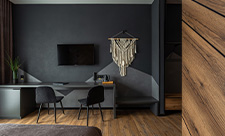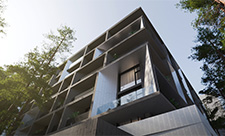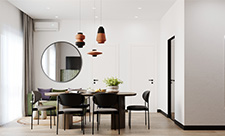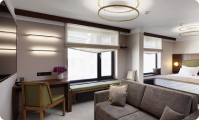Author: Olga Yesvandzhiya, architect-conceptologist of Ribas Hotels Group
What determines the spirit of the hotel? Oddly enough, not hotel rooms and personal space, but social areas such as lobbies, coworking spaces, restaurants, and bars. They form the way guests think about the place, and this must be taken into account when designing hotels. Previously, it was guests whose priority was comfort and the interior of the room, bed, and amenities, but now the situation is changing. People spend less and less time in their rooms. During a trip or a business trip, they look for communication and find it in common spaces.
Hotel social spaces: different, but thought out to the smallest detail
What should be modern social spaces? It all depends on the characteristics of a particular object, its marketing positioning, and target audience. For example, a hotel project in mountainous regions may include a large lobby with a fireplace area where guests can warm up after the rink and enjoy a cocktail. Speaking about business hotels, the lobby can be more modest, but at the same time create a comfortable atmosphere for work and meetings. Such an individual approach allows each hotel to form a unique concept that meets its main tasks and any guests' needs.
It is interesting to review the changes in social spaces on the example of the hotel lobby because it is impossible to be missed during the visit. In old five-star hotels, it was a bright hall, more like an opera house. Guests wanted to either escape as far as possible from demonstrative luxury or vice versa to behave like at social events. Now, lobbies are becoming more alive, they are created for people and their leisure. They are getting more comfortable and functional – it must be emphasized because it is really important. But again, it all depends on the type and location of the hotel. Of course, the project of the aparthotel will be radically different from the large hotel and entertainment complex in the mountains.
Trends in design
Modern design solutions during the design stage are aimed at creating comfort and atmosphere. For example, Ribas Karpaty has a rather small cozy lobby, which expands visually due to the connection with the restaurant. Nevertheless, the key element in it is precisely the fireplace area, where guests wait for their friends or communicate after an active day on the slopes.

In the photo: Ribas Karpaty hotel (Bukovel)
Let's talk about the main macro trends in hotel architecture. First of all, it is worth noting environmental initiatives. The trend for more natural materials has always existed, because we instinctively gravitate to natural structures – if only because they are more pleasant to touch. Therefore, I include this in the trends, but with the amendment that this is always an actual classic.
The next aspect is the architecture of light. At the moment, I can't call it a trend, but more and more people began to pay attention to it. Lighting design creates real magic. Proper lighting turns the room into a completely different space, and you can even get 2-3 different lobbies without partitions and dividing the area.
Trends in the design and architecture of the hotel space are relevant not only for new complexes that are at the design stage of the hotel building. Existing hotels can also adapt their infrastructure and add social spaces. Options for adapting the infrastructure include renovation of the lobby or the area around the hotel, the creation of new spaces for recreation, and communication of guests.
The hotel cannot stand still or be mothballed for years in its original condition. Things are changing and places for people have to evolve first. Therefore, the project of the recreation area goes to the TOP of key tasks during the construction of the perfect complex.
Evolution of hotel spaces
In the dynamic landscape of the hospitality industry, 2023 was a year of transformational change in the role of hotel social spaces. As public preferences continue to evolve, hotels are rethinking these spaces to meet the changing needs and expectations of modern travelers. One of the key aspects of this evolution is interactivity, which involves the integration of new technologies. Smart interactive spaces equipped with innovative amenities will define social areas in 2024. Hotels implement innovations to create an environment that meets the diverse preferences of guests. These are modern coworking spaces for those who come with a business purpose and exciting entertainment areas for travelers on vacation. In addition, if we talk about post-Covid trends, there has been a global transition to online conferences, so Zoom Rooms appear in the social spaces of hotels, where a person can comfortably and quickly hold a meeting. This is a small space with a good internet connection and sound insulation, as well as with comfortable lighting and a beautiful background.
Self-check-in kiosks can also be singled out among the innovations (this is not a new practice in the world for a long time, but in Ukraine they are still not widespread enough). Well, basic minor innovations for comfort that can be implemented in any lobby are wireless chargers, and tablets with a personal assistant based on artificial intelligence that can answer any question the guest may ask.
Culinary experiences will also occupy a central place in the social renaissance of hotel spaces. As tourists seek authentic and unforgettable experiences, hotels are developing gastronomic journeys within their premises. Trendy bars, craft coffee corners, and a variety of food establishments will contribute to hotel social spaces becoming more than just a place to stay. A large non-alcoholic cocktail menu is also a relevant solution.

In the photo: WOL.121 aparthotel (Odesa)
In the nearest future, environmental sustainability will be the driving force forming the design and functionality of common hotel spaces. Hotels are increasingly implementing green practices (from energy-efficient lighting to recycled materials) that align with the values of modern tourists. Today, eco-component is already included in the basic principles of hotel design.
I will give an example from our practice. At WOL.121 in Odesa, the hall has become a place where you want to return. Here, the real heart of the hotel is the reception, bar, bookcases, and a place where you can play board games or go out on the terrace. This area is friendly indeed. By the way, another important thing for the comfort of guests is the height of the reception desk in the lobby. If it is too low and you constantly see the administrator behind the counter, you get the feeling that someone watches you all the time. This kind of lobby is no longer a place to relax. High reception counters have several advantages at once. First, they create comfort for the administrator, where they have a little space for themselves. Secondly, they create a private atmosphere for guests, who don't feel in control.

In the photo: WOL.121 aparthotel (Odesa)
I believe that hotels without common spaces can exist only in those places where high attendance is already ensured. For example, in the center of Paris or on Deribasivska Street in Odesa, where local sights attract tourists even without additional premises. However, the presence of a social space significantly improves the attractiveness of the hotel – perhaps by more than 70%. And you definitely need it when designing your own. Common spaces create opportunities for communication and interaction even if guests do not get to know other residents. They allow the tourist to establish a personal connection with the hotel, get to know the staff and feel the friendly atmosphere. Thanks to its common space, the hotel is associated not only with a comfortable bed that can be found in any other establishment but also with a unique experience gained in the social areas of the lobby or restaurant.
Creation of a hotel design project with Ribas Hotels Group. More details follow the link.
Subscribe to our blog to keep up-to-date with hospitality market trends!
















